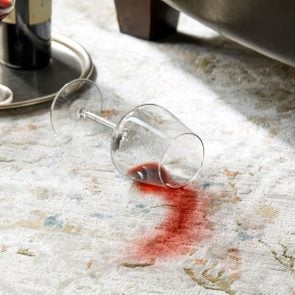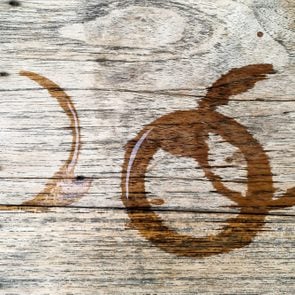How to Remove Permanent Marker Stains from Any Surface, According to Cleaning Pros
Updated: Apr. 19, 2024
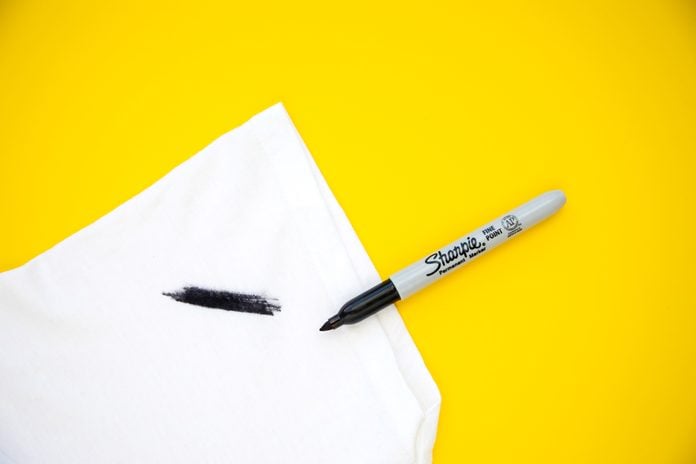
Permanent markers don't necessarily leave behind permanent stains. Here's how to remove permanent marker from denim, leather, wood, walls and more.
Contrary to their name, permanent markers don’t necessarily cause permanent damage. So whether a topless Sharpie went rogue in your leather purse or your kids decided to doodle on the cabinets, you simply need to know how to remove permanent marker stains like a pro. Just remember: Speed is your friend.
If you know how to remove stains, you’re likely aware that the quicker you act when dealing with a Sharpie stain, the greater chance you have at successfully removing the ink before it really does become permanent. In many ways, permanent markers have more in common with spray paint than they do with a ballpoint pen. And that’s because permanent markers are typically formulated with an alcohol base (rather than water or oil), which evaporates rapidly as it dries.
For a step-by-step guide on how to remove permanent marker, we spoke with two experts on how to clean: Wendy Saladyga, a stain and fabric-care specialist at Persil Laundry, and home-cleaning professional Amber Hendrickson.
(While you’re at it, also figure out how to get crayons off the wall.)
Get Reader’s Digest’s Read Up newsletter for more cleaning, humor, travel, tech and fun facts all week long.
About the experts
Reviewed for accuracy by: Ann Russell, TikTok’s “cleaning auntie” and the author of How to Clean Everything. |
What removes permanent marker?
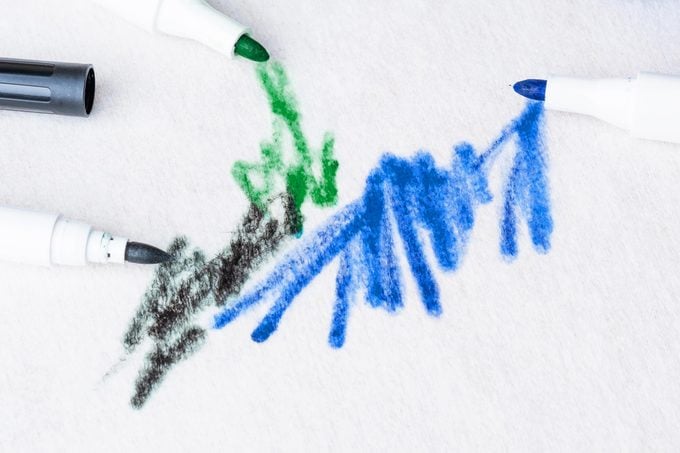
There are many supplies that can tackle permanent marker stains, including rubbing alcohol, alcohol-based hand sanitizer, distilled white vinegar, nail polish remover, makeup remover wipes (best for skin) and even vegetable oil. According to the experts, in most cases, alcohol-based products tend to be the most effective. That’s because they dissolve the pigments and resins in the ink stain, making them easier to lift off the surface.
That said, it depends on the surface you’re cleaning. As you would during your routine cleaning schedule, it’s always important to spot test. Also, avoid placing alcohol directly onto fabrics without diluting first and make sure you’re using the appropriate cleaning technique for the stained item. For example, rubbing alcohol can remove Sharpie stains from many surfaces but should never be used on a natural fabric, such as silk or wool.
You’ll also need to consider how porous the surface is: The more porous the surface (like marble or natural stone), the more difficult the stain will be to remove. Whiteboards, for example, are extremely non-porous, which means you can actually just write over the permanent marker with a dry-erase marker and wipe it up, Hendrickson says. (This trick also works great for most metal surfaces.)
How to get permanent marker out of clothes
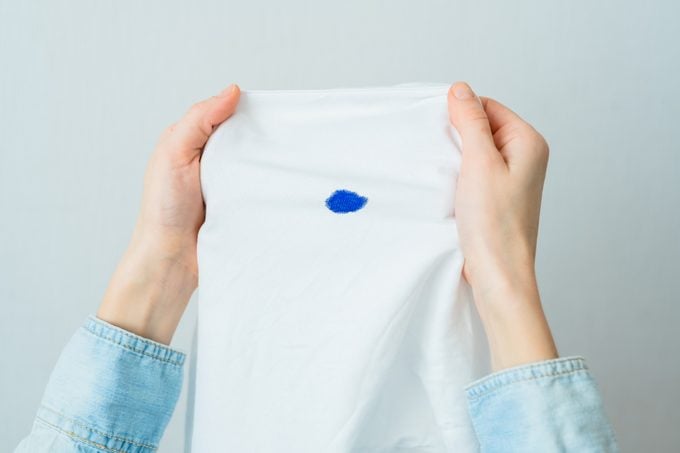
As a rule of thumb for removing permanent marker stains from clothing, always test a small, inconspicuous area first so you can see how your specific garment reacts. Every fabric will have its own needs, and some are more delicate than others. “It is beneficial to conduct a spot test in an inconspicuous spot to ensure the process will not damage the fabric,” Saladyga says. She adds that it’s also very “important to check the care label on your item before attempting to clean.” This ensures you’re laundering and drying the garment in a way that won’t damage the fabric.
How to get permanent marker out of cotton, denim and polyester
Most cotton can handle alcohol-based products, such as rubbing alcohol or nail polish remover, and these are going to be some of the most effective options, Hendrickson says. If your garment is older or thinner cotton, you can try diluting the rubbing alcohol in water, using a one-to-one ratio. Denim (a type of cotton) is also sturdy and tough enough to handle the most effective pigment removers, like rubbing alcohol or nail polish remover. And similarly, because polyester is a tough, human-made fabric, it is sturdy enough to handle alcohol-based removal.
Supplies you’ll need
- Rubbing alcohol
- Acetone-based nail polish remover
- White cloth
Directions
- Apply rubbing alcohol or acetone to a clean cloth or cotton ball. Never pour it directly onto the garment. If your fabric is thinner, dilute with water. Spot test.
- Dab the cloth onto the permanent marker stain and allow it to soak for at least five minutes.
- Blot with a clean, dry cloth or cotton ball.
- Repeat as needed.
- Once you’ve removed what residue you can, wash with a deep-cleaning detergent, advises Saladyga.
- If the stain persists, repeat the process. Do not put it through the dryer if the stain remains, as this can further set the pigment into the fabric fibers.
- Once the stain is removed, follow the on-label care instructions for drying.
How to get permanent marker out of wool
“Wool is a tricky fabric because it comes both in washable and dry-clean only varieties,” Saladyga notes. “Therefore, it’s so important to check the care label on your item before attempting to clean.” For nonwashable items, she recommends taking your stained garment to the dry cleaner. If the wool is washable, you should carefully pre-treat the stains on this delicate fabric. “For pre-treatment, use a lint-free cloth and mild soap or detergent, carefully working to remove stains,” Saladyga advises.
Supplies you’ll need
- White microfiber cloth or paper towel
- Dish soap or laundry detergent
Directions
- Add a few drops of dish soap or liquid laundry detergent to 1 cup of warm water and mix well.
- Dip a clean microfiber cloth or paper towel into the water. Spot test.
- Blot the stain. Press firmly to help transfer the permanent marker ink onto the towel. Don’t scrub.
- Once you’ve pre-treated your stains, follow the care label instructions for washing. “Items like washable wool coats can be turned inside out and washed,” Saladyga says, recommending a gentle cycle with cold water and a mild in-wash detergent.
- Dry according to the on-label instructions.
How to get permanent marker out of leather
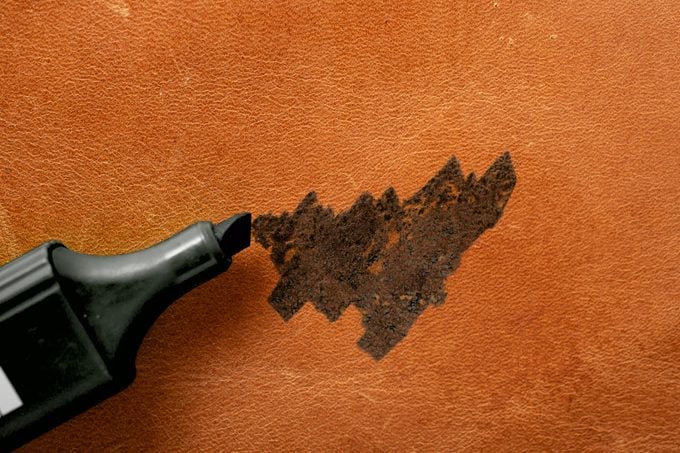
Saladyga says that leather is another finicky fabric and cleaning leather requires delicate care. Alcohol and acetone-based products can easily damage leather, so it’s best to avoid products such as hairspray, nail polish remover, hand sanitizer and rubbing alcohol. Diluted white vinegar is an option you can try, but spot test first. If the below doesn’t work—or your leather reacts negatively to the diluted white vinegar solution—Saladyga says to consult a leather professional or a dry cleaner who’s familiar with leather.
Supplies you’ll need
- White vinegar
- Water
- Cotton ball
- White cloth or paper towel
Directions
- Combine equal parts white vinegar and water.
- Dampen a cotton ball, cloth or paper towel with your vinegar solution. Spot test.
- Press it onto the stained area. Let it set for five minutes.
- Blot the area with a newly damp cloth or cotton ball and be sure to replace the cloth regularly as ink is removed.
- Repeat as needed.
- Blot with a dry cloth or paper towel to remove moisture.
How to get permanent marker off carpet and upholstery
The best option for removing permanent marker from carpet and upholstery is often rubbing alcohol, Hendrickson says. Follow these steps, making sure to spot test in a hidden area first.
Supplies you’ll need
- Isopropyl alcohol
- White microfiber towel
- Dish soap or laundry detergent
- Water
Directions
- Apply isopropyl alcohol onto a clean microfiber towel. Spot test.
- Press onto the permanent marker stain and hold for five seconds. “The stain will start to transfer to the towel and off your carpet or upholstery,” Hendrickson says.
- Repeat, dabbing the stain with clean parts of the cloth (or a new cloth altogether) to prevent transferring ink to other areas, Hendrickson advises. Do not rub or scrub, which can also transfer the ink and spread the stain.
- Repeat until the stain is gone.
- Add 1 tablespoon of dish soap or laundry detergent to 2 cups of water to create a sudsy mixture. Dip a clean cloth into the mixture and blot/dab to remove the rubbing alcohol.
- Repeat, this time with a cloth dipped only in water.
- Air-dry.
How to remove permanent marker from skin
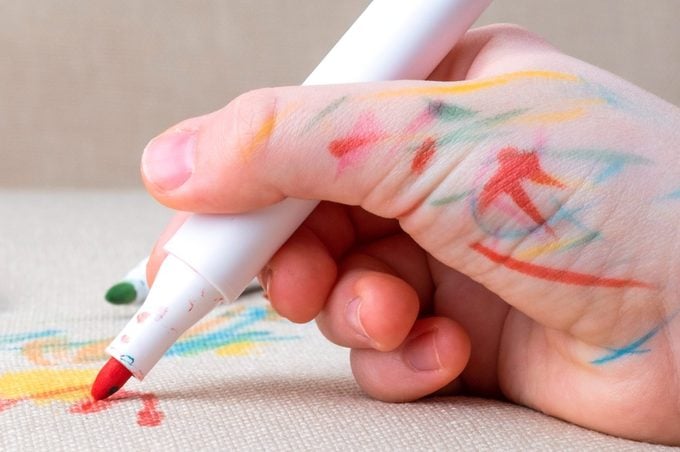
Sure, rubbing alcohol and acetone can remove permanent marker from your skin, but it’s best to reach for something a bit gentler. Try a skin-friendly solvent like hand sanitizer (formulated with a less-concentrated amount of alcohol) or makeup remover to break down the Sharpie stain. Another option: baby oil or olive oil. In addition to making your skin soft and smooth, these common household oils are great for getting a stain off your skin. Whichever stain remover you choose, the removal process remains the same.
Supplies you’ll need
- Hand sanitizer or makeup remover or baby oil/olive oil
Directions
- Apply the stain remover to a soft cloth, paper towel or even your hand. Be sure not to use something too abrasive, as you could irritate your skin.
- Rub in small circles, adding additional sanitizer or oil as needed.
- Go slowly so you don’t irritate your skin in the process.
How to get permanent marker off wood
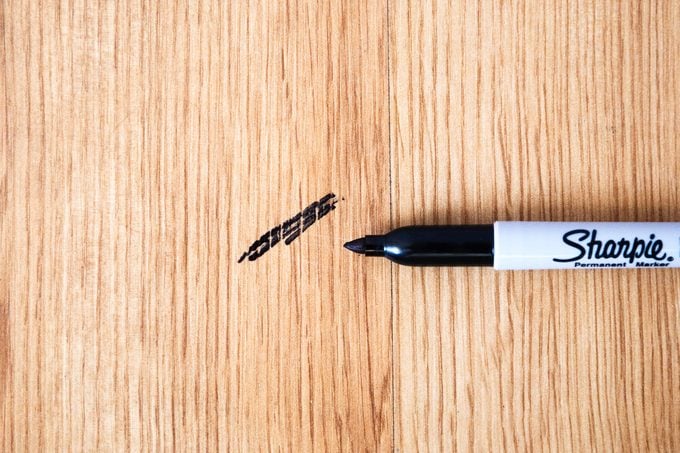
Wood typically has a variety of finishes, and you’ll want to take this into account when removing permanent marker stains. Since finished wood is much less porous than unfinished wood, it will be more resistant to permanent marker ink stains and more durable when it comes to choosing solutions. Keep in mind that you’ll always want to dilute whatever solution you choose, and never pour concentrated ingredients directly onto the floor, since they can eat through finishes. No matter the method, it’s best to start with a hidden area first, since there’s a great deal of variety when it comes to woods and finishes.
Supplies you’ll need
- Pencil eraser
- Rubbing alcohol or acetone
- Water
- Microfiber cloth
Directions
- First, see if using a simple pencil eraser will remove the stain from the wood’s surface. This is more likely to work on finished wood.
- If that doesn’t work, combine one part rubbing alcohol or acetone and one part water in a bowl, Hendrickson says. Do not apply these products undiluted, since they can eat through the wood.
- Apply the mixture to a clean cloth.
- Gently rub back and forth over the stain until it’s removed.
- Wipe with a damp cloth.
- Air-dry.
How to remove permanent marker from plastic
Removing permanent marker stain from plastic is easier than you might think. For most plastics, especially hard plastics, you can simply draw over the permanent marker with a dry erase marker and wipe it away with a paper towel. There’s no need to let it sit. If this doesn’t work, try one of the below techniques.
Supplies you’ll need
- Pencil eraser
- Rubbing alcohol or acetone
- Microfiber cloth
Directions
- If the stain is still fresh and not set too deep, scrub the ink away with a pencil eraser. Use a large eraser and scrub with some decent pressure.
- If that doesn’t work or if the stain is too set, apply rubbing alcohol or acetone to a clean cloth or cotton ball.
- Press the cloth onto the ink stain for 15 to 30 seconds.
- Wipe away with a clean, dry cloth and repeat as needed.
How to get permanent marker off the wall
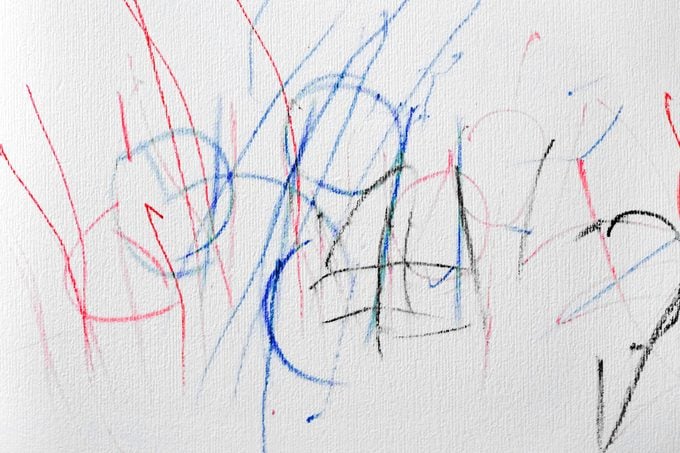
Most parents have suffered at least one permanent marker accident over the years. Luckily, since most walls are painted, it is usually pretty easy to remedy, as paint can actually resist the permanent ink pretty well. Still, you don’t want to use anything that’s going to strip the paint. We’ve got three options for you to try below. Start with the first option (dry erase marker). If that doesn’t work, move on to the second (glass cleaner and Magic Eraser). If that’s ineffective, then move on to the third (rubbing alcohol).
Supplies you’ll need
- Dry erase marker
- Glass cleaner
- Magic Eraser
- Rubbing alcohol
- Dish soap
- Water
Option 1: Dry erase marker
- Using a dry erase marker, draw over the permanent marker spot. (Make sure to triple check that the marker you’re using is a dry erase marker and not another Sharpie.)
- Wipe away using a microfiber cloth. While it might seem counterproductive to use another marker on your walls, this trick can be very effective and puts very little stress on the paint.
Option 2: Glass cleaner and Magic Eraser
- Spray the wall with Windex or another glass cleaner. No need to hold back here—feel free to use as much as you need. Do not rinse or wipe away.
- Gently scrub the stained area with a Magic Eraser, which is like ultra fine sandpaper, using a lot of pressure.
- Follow up with soapy water and a microfiber cloth to remove any residue.
- Wipe with a damp cloth and let air-dry.
Option 3: Rubbing alcohol
- Dilute alcohol in water with a one-to-one ratio.
- Soak a clean cloth in the mixture.
- Wipe the cloth back and forth over the stained wall to remove the ink.
- Follow up with soapy water to remove any residue.
- Wipe with a damp cloth and let air-dry.
How to get permanent marker off non-wood countertops
Knowing how to clean countertops is important so you don’t damage the material. Luckily, most counters are pretty resilient and won’t get damaged by certain types of alcohol, which makes it a great option for marker stain removal. In fact, you can even use diluted isopropyl alcohol on marble. Here’s what Hendrickson recommends.
Supplies you’ll need
- Spray bottle
- Isopropyl alcohol
- Water
Directions
- Combine equal parts water and isopropyl alcohol in a spray bottle.
- Spray the stained area.
- Wipe with a non-scratch sponge or microfiber towel.
- Repeat Steps 2 and 3 as needed.
- Wipe with a damp cloth and let air-dry.
How to get permanent marker off metal
Permanent ink comes off metal pretty quickly with rubbing alcohol. While the same dry erase marker trick will work with non-porous metal, you’ll probably find that the best option is to simply use plenty of rubbing alcohol.
How to remove permanent marker from tile
Similarly, tile is very resilient and will stand up nicely to rubbing alcohol. Hendrickson says to follow the same steps as you would for countertops. “If you are in a pinch and don’t have any isopropyl alcohol on hand, you can use hairspray or hand sanitizer for either,” she says.
How to get permanent marker off a whiteboard
“Have you ever accidentally used a permanent marker on your whiteboard instead of an Expo marker? I’ll admit it, I have,” Hendrickson says. “The easiest way to fix the mistake is to draw over the permanent marker with your Expo marker and wipe clean. The permanent marker will come right off.”
Why trust us
At Reader’s Digest, we’re committed to producing high-quality content by writers with expertise and experience in their field, in consultation with relevant, qualified experts. For this piece, Leah Groth tapped her experience as a longtime home and lifestyle writer. Then cleaning expert Ann Russell, author of How to Clean Everything, gave it a rigorous review to ensure that all information is accurate and offers the best possible advice to readers. For this piece, we relied on reputable primary sources, including cleaning and health experts and reputable government agencies. We verified all facts and data and backed them with credible sourcing, and we will revisit them over time to ensure they remain accurate and up to date. Read more about our team, our contributors and our editorial policies.
Sources:
- Wendy Saladyga, stain expert and senior manager of technical performance for Persil Laundry and All Laundry
- Amber Hendrickson, home cleaning professional and the founder of Bubbles and Buckets Cleaning in Albertville, Minnesota

